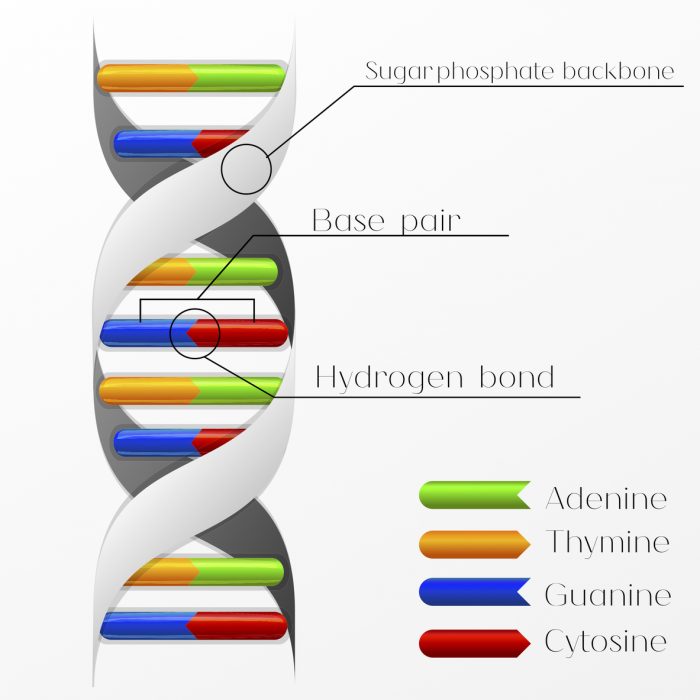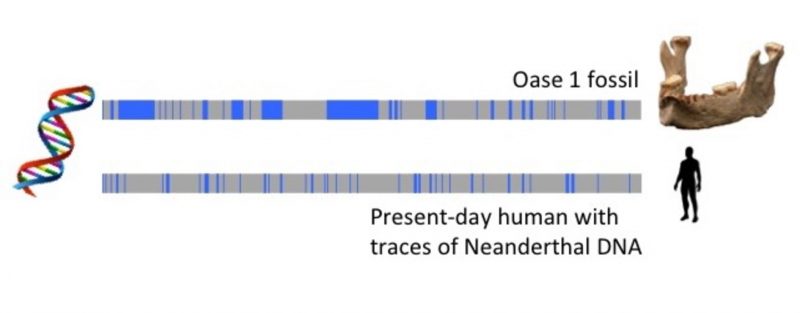
Our annual fund-raiser is here! Help EarthSky stay an independent voice.
By Bridget Alex, Harvard University and Priya Moorjani, Columbia University
DNA holds the story of our ancestry – how we’re related to the familiar faces at family reunions as well as more ancient affairs: how we’re related to our closest nonhuman relatives, chimpanzees; how Homo sapiens mated with Neanderthals; and how people migrated out of Africa, adapting to new environments and lifestyles along the way. And our DNA also holds clues about the timing of these key events in human evolution. ![]()
When scientists say that modern humans emerged in Africa about 200,000 years ago and began their global spread about 60,000 years ago, how do they come up with those dates? Traditionally researchers built timelines of human prehistory based on fossils and artifacts, which can be directly dated with methods such as radiocarbon dating and Potassium-argon dating. However, these methods require ancient remains to have certain elements or preservation conditions, and that is not always the case. Moreover, relevant fossils or artifacts have not been discovered for all milestones in human evolution.
Analyzing DNA from present-day and ancient genomes provides a complementary approach for dating evolutionary events. Because certain genetic changes occur at a steady rate per generation, they provide an estimate of the time elapsed. These changes accrue like the ticks on a stopwatch, providing a “molecular clock.” By comparing DNA sequences, geneticists can not only reconstruct relationships between different populations or species but also infer evolutionary history over deep timescales.
Molecular clocks are becoming more sophisticated, thanks to improved DNA sequencing, analytical tools and a better understanding of the biological processes behind genetic changes. By applying these methods to the ever-growing database of DNA from diverse populations (both present-day and ancient), geneticists are helping to build a more refined timeline of human evolution.
How DNA accumulates changes
Molecular clocks are based on two key biological processes that are the source of all heritable variation: mutation and recombination.

Mutations are changes to the letters of DNA’s genetic code – for instance, a nucleotide Guanine (G) becomes a Thymine (T). These changes will be inherited by future generations if they occur in eggs, sperm or their cellular precursors (the germline). Most result from mistakes when DNA copies itself during cell division, although other types of mutations occur spontaneously or from exposure to hazards like radiation and chemicals.
In a single human genome, there are about 70 nucleotide changes per generation – minuscule in a genome made up of six billion letters. But in aggregate, over many generations, these changes lead to substantial evolutionary variation.
Scientists can use mutations to estimate the timing of branches in our evolutionary tree. First they compare the DNA sequences of two individuals or species, counting the neutral differences that don’t alter one’s chances of survival and reproduction. Then, knowing the rate of these changes, they can calculate the time needed to accumulate that many differences. This tells them how long it’s been since the individuals shared ancestors.
Comparison of DNA between you and your sibling would show relatively few mutational differences because you share ancestors – mom and dad – just one generation ago. However, there are millions of differences between humans and chimpanzees; our last common ancestor lived over six million years ago.

Recombination, also known as crossing-over, is the other main way DNA accumulates changes over time. It leads to shuffling of the two copies of the genome (one from each parent), which are bundled into chromosomes. During recombination, the corresponding (homologous) chromosomes line up and exchange segments, so the genome you pass on to your children is a mosaic of your parents’ DNA.
In humans, about 36 recombination events occur per generation, one or two per chromosome. As this happens every generation, segments inherited from a particular individual get broken into smaller and smaller chunks. Based on the size of these chunks and frequency of crossovers, geneticists can estimate how long ago that individual was your ancestor.

Building timelines based on changes
Genetic changes from mutation and recombination provide two distinct clocks, each suited for dating different evolutionary events and timescales.
Because mutations accumulate so slowly, this clock works better for very ancient events, like evolutionary splits between species. The recombination clock, on the other hand, ticks at a rate appropriate for dates within the last 100,000 years. These “recent” events (in evolutionary time) include gene flow between distinct human populations, the rise of beneficial adaptations or the emergence of genetic diseases.
The case of Neanderthals illustrates how the mutation and recombination clocks can be used together to help us untangle complicated ancestral relationships. Geneticists estimate that there are 1.5-2 million mutational differences between Neanderthals and modern humans. Applying the mutation clock to this count suggests the groups initially split between 750,000 and 550,000 years ago.
At that time, a population – the common ancestors of both human groups – separated geographically and genetically. Some individuals of the group migrated to Eurasia and over time evolved into Neanderthals. Those who stayed in Africa became anatomically modern humans.

However, their interactions were not over: Modern humans eventually spread to Eurasia and mated with Neanderthals. Applying the recombination clock to Neanderthal DNA retained in present-day humans, researchers estimate that the groups interbred between 54,000 and 40,000 years ago. When scientists analyzed a Homo sapiens fossil, known as Oase 1, who lived around 40,000 years ago, they found large regions of Neanderthal ancestry embedded in the Oase genome, suggesting that Oase had a Neanderthal ancestor just four to six generations ago. In other words, Oase’s great-great-grandparent was a Neanderthal.

The challenges of unsteady clocks
Molecular clocks are a mainstay of evolutionary calculations, not just for humans but for all forms of living organisms. But there are some complicating factors.
The main challenge arises from the fact that mutation and recombination rates have not remained constant over human evolution. The rates themselves are evolving, so they vary over time and may differ between species and even across human populations, albeit fairly slowly. It’s like trying to measure time with a clock that ticks at different speeds under different conditions.
One issue relates to a gene called Prdm9, which determines the location of those DNA crossover events. Variation in this gene in humans, chimpanzees and mice has been shown to alter recombination hotspots – short regions of high recombination rates. Due to the evolution of Prdm9 and hotspots, the fine-scale recombination rates differ between humans and chimps, and possibly also between Africans and Europeans. This implies that over different timescales and across populations, the recombination clock ticks at slightly different rates as hotspots evolve.
Another issue is that mutation rates vary by sex and age. As fathers get older, they transmit a couple extra mutations to their offspring per year. The sperm of older fathers has undergone more rounds of cell division, so more opportunities for mutations. Mothers, on the other hand, transmit fewer mutations (about 0.25 per year) as a female’s eggs are mostly formed all at the same time, before her own birth. Mutation rates also depend on factors like onset of puberty, age at reproduction and rate of sperm production. These life history traits vary across living primates and probably also differed between extinct species of human ancestors.
Consequently, over the course of human evolution, the average mutation rate seems to have slowed significantly. The average rate over millions of years since the split of humans and chimpanzees has been estimated as about 1×10?? mutations per site per year – or roughly six altered DNA letters per year. This rate is determined by dividing the number of nucleotide differences between humans and other apes by the date of their evolutionary splits, as inferred from fossils. It’s like calculating your driving speed by dividing distance traveled by time passed. But when geneticists directly measure nucleotide differences between living parents and children (using human pedigrees), the mutation rate is half the other estimate: about 0.5×10?? per site per year, or only about three mutations per year.
For the divergence between Neanderthals and modern humans, the slower rate provides an estimate between 765,000-550,000 years ago. The faster rate, however, would suggest half that age, or 380,000-275,000 years ago: a big difference.
To resolve the question of which rates to use when and on whom, researchers have been developing new molecular clock methods, which address the challenges of evolving mutation and recombination rates.
New approaches for better dating
One approach is to focus on mutations that arise at a steady rate regardless of sex, age and species. This may be the case for a special type of mutation that geneticists call CpG transitions by which the C nucelotides spontaneously become T’s. Because CpG transitions mostly do not result from DNA copying errors during cell division, their rates should be mainly independent of life history variables – and presumably more uniform over time.
Focusing on CpG transitions, geneticists recently estimated the split between humans and chimps to have occurred between 9.3 and 6.5 million years ago, which agrees with the age expected from fossils. While in comparisons across species, these mutations seem to happen more like clockwork than other types, they are still not completely steady.
Another approach is to develop models that adjust molecular clock rates based on sex and other life history traits. Using this method, researchers calculated a chimp-human divergence consistent with the CpG estimate and fossil dates. The drawback here is that, when it comes to ancestral species, we can’t be sure of life history traits, like age at puberty or generation length, leading to some uncertainty in the estimates.
The most direct solution comes from analyses of ancient DNA recovered from fossils. Because the fossil specimens are independently dated by geologic methods, geneticists can use them to calibrate the molecular clocks for a given time period or population.
This strategy recently resolved the debate over the timing of our divergence with Neanderthals. In 2016, geneticists extracted ancient DNA from 430,000-year-old fossils that were Neanderthal ancestors, after their lineage split from Homo sapiens. Knowing where these fossils belong in the evolutionary tree, geneticists could confirm that for this period of human evolution, the slower molecular clock rate of 0.5×10?? provides accurate dates. That puts the Neanderthal-modern human split between 765,000 to 550,000 years ago.
As geneticists sort out the intricacies of molecular clocks and sequence more genomes, we’re poised to learn more than ever about human evolution, directly from our DNA.
Bridget Alex, Postdoctoral College Fellow, Department of Human Evolutionary Biology, Harvard University and Priya Moorjani, Postdoctoral Research Fellow in Biological Sciences, Columbia University
This article was originally published on The Conversation. Read the original article.











